Luohan (罗汉) is a term originating from Buddhism and is called Arhat (अर्हत) or Arahant in sanksrit and pali respectively. It is used in Chinese Buddhism to describe a practitioner which was had a higher level of attainment or pre-enlightenment but has not become a Boddhisattva, or a Buddha. The Luohan are also considered semi saint like and are often as disciples of Guatama Buddha who were instructed to await the coming of the Matreiya (future Buddha). Depending on the sutra (Buddhist Scripture) there are between 4 – 16 Luohan in early Indian and Tibetan texts. After the Ming Dynasty, 18 Luohans were part of Chinese Buddhism.
The first reference of the 16 Luohan dates back to 891 AD, when a monk Guan Xiu painted portaits of the Luohan. During that time Buddhists had undergone a period of persecution from the Emperor Tang Wuzong and a group of faithful had taken the Luohan as guardians at the time. One of the oldest known statues of such depiction are from Yixian county, Hebei Province.
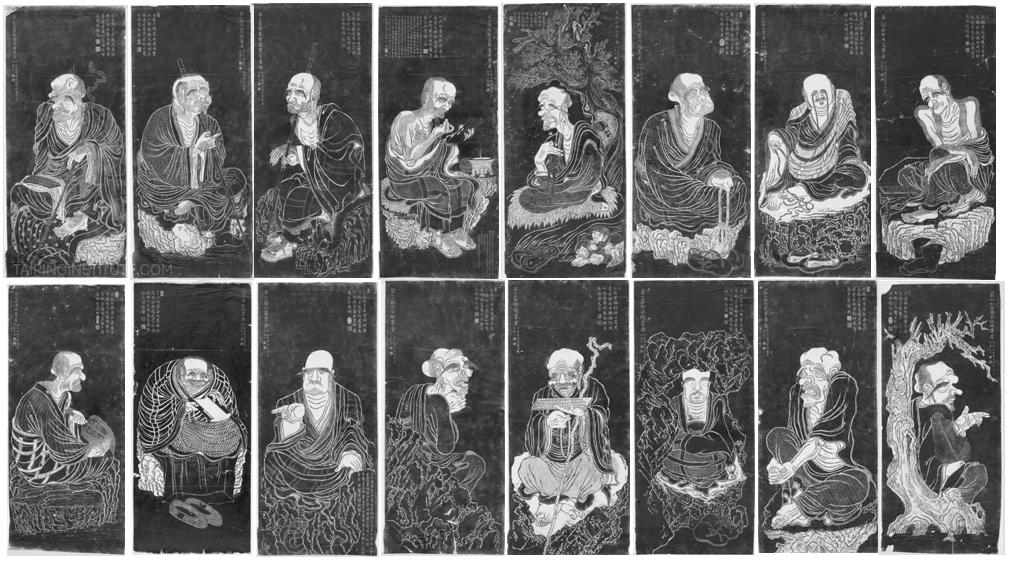
The Luohan in their original depictions prior to entering the Chinese Buddhism, did not have the emotional and differentiating characteristics that would be endowed upon in the future. In fact many held the Luohan with great reverance and even the Emperor QIanlong from the Qing Dynasty visited the Guan Xiu paintings (stored at the Shengyin Temple, Hangzhou) and was said to admire them greatly. He even wrote a set of eulogy for each of the Luohan which influenced the depiction until this day.
In martial arts terms, there are some folklore and legend which attribute the Luohan to the time of Boddidharma and his time in the Central Plains of China, where the famous Shaolin Temple on Shao Shi Peak of Song Mountain is located. The legend suggests creation of something thought to be 18 hands of luohan. This however is questionable given that Boddhidharma is of the Indian buddhism tradition and through the sheer concept of Ch’an (Zen) which he is the associated founder, it would be peculiar to show reverance to Luohan (especially all 18 of them, when some had not yet been created then).
What is lesser known or correlated is the practice of the White Lotus groups that were sub Daoist, Buddhist and general Chinese culural religious faiths that believed in the coming of the Matreiya as well as placing many historical and religious figures into their reverance system. Some parts of these groups also practiced martial arts and it is likely the path by which the Luohan were to be included into their practice.
There are many schools of Luohan Quan which have arisen across China, some from the Central Plains area (Hebei, Henan and Shandong), others from the Southeastern coast (Zhejiang, Fujian) and some in the West (Sichuan). Each not necessarily related as much as commonly inspired by the Luohan. To the practices in those three main areas, there are again many variations and schools thereof.
Although Luohan Quan is a main feature in Shaolin Quan (for more information visit our details here), its practice does not hold the symbollic practice as found in some of the styles of southeastern coast. It is these styles of the Jiangnan to which our Luohan Quan is derived and thus expounded upon herein.
The beauty of the Luohan Quan from Jiangnan is in its direct association between the buddhist ideals and the practice, between the descriptive aspects of the Luohan and the techniques within the boxing. It is unfortunate that this style is rarely held in its completeness in present times, possibly because of the great skills that understanding parts of the style already can impart or due to the common practice of masters finding an affiniation with only one or some of the Luohan thereby ignoring others. After an almost 20 year expedition of practice and discovery across Zhejiang and Fujian province the composition of the many pieces of the style are detailed herein.
The art of the 18 Luohans and their significance
The history of Luohan (Arhats) in China can be dated to arts works in 891 AD, when a monk Guan Xiu painted portaits of the 16 Luohan. The first paintings depicted only sixteen (16) Arhats and even this was an increase from an original four.
The Ekottara-agama (Numbered Discourses from the Buddhist Canon), records a tradition that the Buddha appointed four Luohan – Mahakasyapa, Kundopadhaniya, Pindola, and Rahula, to remain in the world and not achieve final Nirvana until Maitreya, the next Buddha, arrived. They were to guard the Dharma. A later work, the Mahayanavataraka-sastra, then expands the list to sixteen, eliminating Mahakasyapa and Kundopadhaniya, but retaining Pindola, and Rahula as well as fourteen other Luohan (unamed at the time). These were subsequently identified in a Chinese work of art which brought the number up to 16 (and sixteen is the standard number in Tibet and Japan). The last two were to be added much later (even as late as the 17th century).
In Mahayana tradition, the Buddha often met on Mount Gridhrakrta (Vulture’s Peak) in central India. Often with a grand assembly of natural and supernatural beings: “monks and Luohan, Boddhisattvas of foreign lands, incalculable numbers of gods, dragons, yaksas, asuras, and other sentient beings.” He would deliver his sermons, later to become sutras. So the Luohan were key attendants of the Buddha’s teachings, and later came to be seen as guardians.
According to the Lankavatara Sutra, there are 10 stages on the path to becoming a Bodhisattva. At the sixth stage some do not complete fully and therefore become Luohan rather than Boddhisattvas. In Mahayana Buddhism, the Luohan stage is essential to go through prior to becoming a Boddhisattva which is about cultivating wisdom. It is because of this that the Luohan are considered in high regard within Chinese Mahayana Buddhism.
The 18 Luohan
| Rahula, Thinking Lohan,(沉思罗汉, Chen Si Luo Han) Pindola the Bharadvaja, Deer Sitting Lohan, (骑鹿罗汉, Qi Lu Luo Han) Nandimitra, Raised Pagoda Lohan, (托塔罗汉,Tuo Ta Luo Han) Pantha, Raised Hand Lohan, ( 探手罗汉,Tan Shou Luo Han) Bodhidharma, Overseas Lohan, (过江罗汉, Guo Jiang Luo Han) Vanavasa, Plantain Lohan,(芭蕉罗汉 Ba Jiao Luo Han) Nakula, Meditating Lohan, (静座罗汉 Jing Zuo Luo Han) Kalika, Elephant Riding Lohan, ( 骑象罗汉 Qi Xiang Luo Han) Pantha, Doorman Lohan, ( 看门罗汉, Kan Men Luo Han) | Nantimitolo, Taming Dragon Lohan,( 降龙罗汉, Jiang Long Luo Han) Kanaka the Bharadvaja, Raised Bowl Lohan, ( 举钵罗汉,Ju Bo Luo Han) Angida, Calico Bag Lohan, 布袋罗汉,Bu Dai Luo Han. Asita, Long Eyebrow Lohan (长眉罗汉,Chang Mei Luo Han) Gobaka, Open Heart Lohan, (开心罗汉,Kai Xin Luo Han) Kanaka the Vatsa, Happy Lohan, (喜庆罗汉, Xi Qing Luo Han) Nagasena, Scratch Ear Lohan, ( 挖耳罗汉,Wa Er Luo Han) Vijraputra, Laughing Lion Lohan, (笑狮罗汉,Xiao Shi Luo Han) Pindola, Taming Tiger Lohan, (伏虎罗汉, Fu Hu Luo Han) |
History of 18 Luohan in Martial Arts
Although many folklore and legends persist and have captured the imagination of many including the most popular variant that Boddhidharma (Da Mo) passed 18 Luohan hands as a form of exercises, the Luohan in martial arts date back to the 17th century. It is after the stories of the Ming Dynasty that the glortifying of legends amongst the Han people were being spread and applied to various cultural and religious movements. The White Lotus group (of which the Ming Dynasty originated from) was very big on the idea in the Qing dynasty. Even the emperor Qianlong was captured by such ideals. The Shaolin Temple in the central plains influenced the concepts in the Central and North of China, and further about the Luohan practiced there is found in the section about Shaolin. In terms of the Southern martial arts the boxing methods of the Minbei region highly influenced by descendants of the Celestial Masters group of Daoists and by the Zhangzhou Hongmen and Hakka efforts in the South (derivatives of the White Lotus movement under the banner of the Tian Di Hui) all played a part in combining boxing methods with names from historical, spiritual and religious figures. It is from those concepts that the Luohan were born and to be taught to generations later. There are over 7 different Luohan Quan styles in Southeastern China alone and many more throughout the country. This are elaborated upon in the next section.
Southern Luohan Boxing Traditions
In terms of Luohan Quan there are many differen styles and thus each with its own history. Some styles have created a history based on legends, others are short to only reach a few generations since their propagation whislt some even include religious lines of monks into their lineage. These will be outlined below to understand how Luohan Quan came to be in the Southeastern areas of China.
In Fujian, there are over 5 different lineages of Luohan Quan recognized ( 3 of which are in Fuzhou, one is Yong Tai Fang Guang Cliff Luohanquan, then there is Fuzhou Luohan Quan (which actually originated in Kai Yuan Temple, Quanzhou in the south) and finally Xiang Dian Quan. There are also Luohan Quan practiced in Zhejiang and Nanyang (Singapore, Malaysia etc). These are introduced below.
Yongfu Luohan Quan (永福罗汉拳, Arhat Boxing from Yongfu, Fujian Province)
This style of Luohan Quan originates in Yong Tai County at the Fang Guang Cliff where it was passed by Monk Bao Kong (宝空). It was Xie Baokuang (谢宝匡) who studied at Fangguang Cliff with Bao Kong the skills of Luohan Quan which he passed onto his disciple.
Chen Dongguan (陈东官) studied under Master Xie and was one of Luohan Quan’s most recognized inheritors (after achieving first place in the inaugaral Fujian Leitai competition in 1932) and taught the boxing in Fuzhou. Liang Shou Zhong was a disciple of Chen Dongguan and selected as representative of Luohan boxing when government researchers came to Fuzhou in the 1980’s as part of the martial arts collection activities.
The sets of Yongfu Luohan Quan include Sanzheng (三正, 3 straights), Babu (八步, 8 steps), Simen (四门, 4 gates), Ershiba Su (二十八宿, 28 ancestors), Sanshiliushou (三十六手, 36 hands) and so on. The style is likely to have been derived or heavily influenced by the old boxing styles in Yongfu which are known as Jishan Quan (集山拳, Integrated Mountain Boxing).
Zhangzhou Luohan Quan ( 漳州 罗汉拳, Arhat Boxing from Zhangzhou, Fujian Province)
Zhangzhou is treasure house of traditional Fujian martial arts. Luohan Quan is also one of the styles prominently found there.
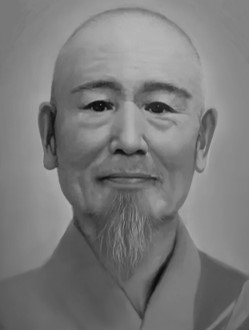
In Zhangzhou there is the Kaiyuan Temple (also one found in Quanzhou of the same name) which is said to have had practitioners of martial arts for many generations, one of the major schools is Shaohua Tang (少华堂). Zhangzhou Luohan Quan is also known as Shiba Luohan Quan (十八罗汉拳, 18 Luohan Boxing), Fojia Quan (佛家拳, Buddha Family Boxing) and Hexiang Quan (和尚拳, Monk Boxing). It is a very elaborate system which includes over 108 routines/forms, with 18 of them being considered the most respected. There are sets like Luohan Shibafa (18 Methods of Arhats), Xiao/Da Luohan (Small/Large Arhat), Fuhu (Tiger Taming), Luohan Shibadie (18 falls of Arhats), Zui Luohan (Drunken Arhat), as well as Xiang Yue Quan (Ape Boxing), Babu Chan (8 Steps), Meihua (Plum Blossom) and much more.
A complete system of internal practices (such as Luohan Jingang Gong, Luohan Jinchan Gong and external practices such as Tiesha Zhang (Iron Plam), Jing Gong (Lightness Skils) and Jinzhong Zhao (Golden Bell Cover). There are also many armed practices with 108 weapons sets (including 35 for long and 72 short weapons) and over 24 combined combat sets. The lineage in brief is as follows: Venerable Master Hui Ming ( 惠明法师 ) – Master Fa Min ( 法敏大师 ) – Monk Guang Chou ( 广袖和尚 ) – Father in Law (岳父) – Pan Yiba ( 潘依八) – Lin Cenghui ( 林增辉). Other Luohan Quan is derived from another Temple in Zhangzhou, the Nashan Si (Southern Mountain Temple) where a monk “Yi Qing” passed down a system of Luohan Quan. In Yuekou, Zhangzhou, M. Lin Youcai also taught Luohan Quan.
Dan Bian Luohan Quan (单鞭罗汉拳, Single Whip Arhat Boxing)
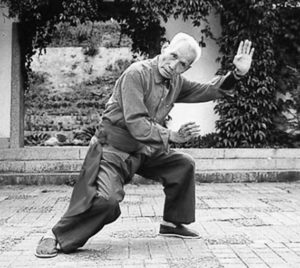
This style is common in the Fuzhou area. The origin of this style is from Zhang Zhongdong (张宗标) in the Qing Dynasty. Master Zhang is said tro have studied with a monk at Shan Feng Temple and later taught the style in Pingnan. The original boxing of the monk was said to have been Longzhuang (also known as Longzun Quan, 龙尊拳, Fujian Dragon Reverence Boxing) as the reference Dan Bian (one of the sets on Longzhuang Quan. There are 18 sets/routines in this Luohan style with names such as 24, 36, 72 and 108 postures. The 108 postures is the essence of Dan Bian Luohan Quan.
Xiang Dian Quan (香店拳, Fragrant Stall Boxing)
Xiang Dian Quan is also known as Luohan Quan or a division thereof and is commonly practices in Pingnan, Fujian Province. In 1918, there was a monk Zhiyuan (智远) who passed by a store called “Qingxiang Tingxiang Dian” and the owner recognised that he has somes skills then asked to study. After much difficulty in persuasion, the monk agreed to teach the young man known as Fang Ligui (房利贵) who studied the Luohan Quan with sincere effort. After he taught others the style was known as Xiangdian in consideration of its origins with Master Fang. His key disciple was Chen Wumei (陈乌妹, 1896-1989) who then passed on the skill to Fang Lizeng (房利增, 1922-1991). Based on the contents and methods of the style current researchers believe the origins to be in Longzun Quan (龙尊拳, Fujian Dragon Reverence Boxing). The sets of this style include San Zhan (三战), Babu (八步), Shizi (十字) and Luohan Shiba Fumo Tui (罗汉十八伏魔腿).
Taizhou Luohan Quan (台州 罗汉拳, Arhat Boxing from Taizhou, Zhejiang Province)
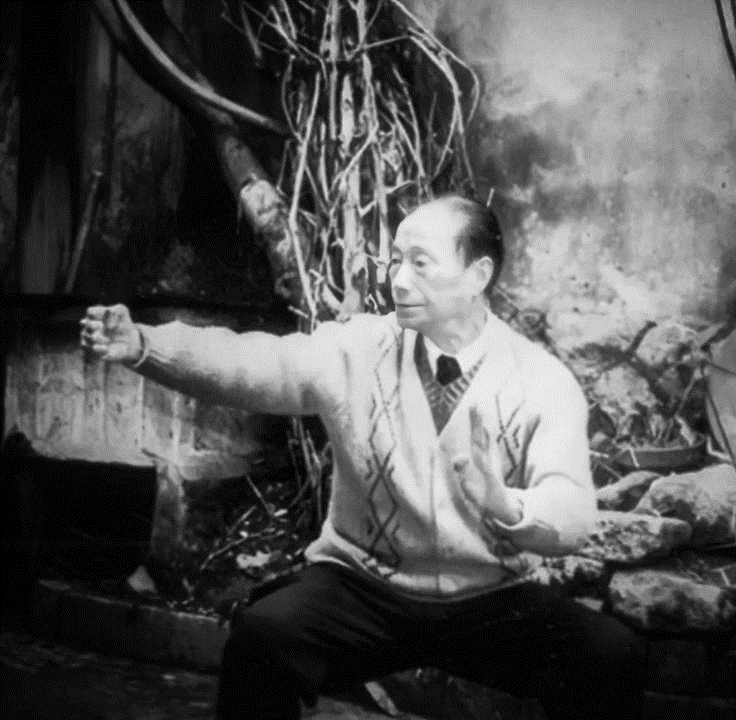
Luohan practiced in Zhejiang was passed by Venerable Monk Ru Ceng (如修) to Master Xi Chengfu ( 奚诚甫). The style’s attributes are in line with those of the Zhejiang region with deep stances, direct powerful striking and use of tensile motions. The contents of the set are said to combine the Yixing (意形, Intention of the Image) based on the Luohan, with the Jiashi (架式, postures) of traditional boxing in Zhejiang.
Its contents include three key aspects of many short sets including the Luohan Shiba Shou (罗汉十八手, 18 Hands of Arhats), individual Luohan Quan ( 罗汉拳, Arhat Boxing) and the drunken shape of Zui Luohan Quan (醉罗汉拳 , Drunken Arhat Boxing). Since Master Xi was already versed in indigenous boxing methods of Zhejiang and the styles close resemblance of that, it is likely that this style really took the concept of Luohan but consists of local boxing methods therein.
Quanzhou Luohan Quan (泉州 罗汉拳, Arhat Boxing from Quanzhou, Fujian Province)
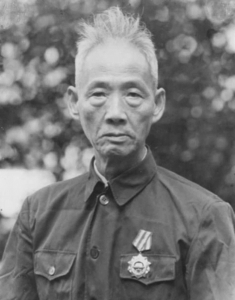
Zhuang Zishen (庄子深, 1913-1988) was an esteemed practitioner of Traditional Chinese Medicine and Martial arts. He was fortunate to receive tuition from many masters in a variety of styles and became an important figure in Fujian martial arts holding posts such as President of the Quanzhou martial arts research society and the Fujian provincial martial arts bureau. In 1988, he commenced the Jianying martial arts Institute. In amongst the martial arts he studied, this included Luohan Quan with Hou Junhuan (侯君焕) in Quanzhou, Fujian Province.
Hou Junhuan used to reside on Xijie (West Road) in Quanzhou, however not much is known of his teachers. Common understanding amongst followers is that he studied with monks in either Kaiyuan Temple (开元寺) or Zhenguodong Chan Temple (镇国东禅寺) . There are three empty hand sets: Luohan San Zhan (罗汉三战, 3 Battles), Xianglong Luohan (降龙罗汉, Dragon Subduing Arhat) and Fuhu Luohan (伏虎罗汉, Tiger Taming Arhat).
Nanyang Fojia Pai (佛家派, Buddhist Family School)
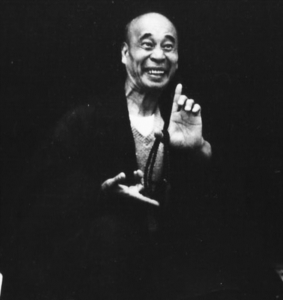
Fojia Pai is sometimes also considered Luohan Quan (because of contents of the same name and close association with Buddhism) was founded by Abbott Shi Gao Can (释高参, Sek Koh Sum) of the Shuanglin Temple, Singapore. Shi Gao Can was originaly from the Huian area in Quanzhou, Fujian province and studied local boxing for three years in his youth, Taizuquan with Cao Biao (曹彪) and later Luohanquan from Zhangzhou later as a monk on Putuoshan (an island of the coast of Zhejiang province). This style consists of elements from Taizu Quan, Luohan Quan mainly as well as some arts from Zhejiang.
Since the founder is said to have practiced methods only passed amongst Buddhist monks, the style is referred to as Fo Jia Pai (Buddhist Family School). Characterized by deeply rooted stances, which are often on a three angled plane the style is direct and consists of simply to execute and apply movements. Sets are numerous and different amongst the various branches but commonly include Yizhi Mei (一枝梅), Luohanquan (罗汉拳), Simen (四门), Xiashan Hu (下山虎) and more rare practices such as Xi Nu Luohan (喜怒罗汉) and Houxing Luohan (猴形罗汉).
Taiping Luohan Quan
Luohan Quan is derived from the styles across Zhejiang, Fujian and Nanyang. It focuses on direct powerful application of all techniques and individual expression of intention, power and methods on the basis of the 18 Luohan. The concept is that each Luohan is represented not just by physical skills, but also by power and spiritual emphasis which has been the basis for most of the Luohan Quan systems throughout history.
There are introductory sets that ensure the right basics are understood, and then followed by individual components which are based on each of the 18 Luohans. In total there are over 18 sequences some short and others long ranging between 12 up to 108 techniques within each sequence. Many of the sets are also matching so that they can be practiced with a partner.

Fundamentals
| 三战 San Zhan (3 Battles) 角战 Jiao Zhan (angled battle) 八步 Ba Bu (8 Steps) 四门 Si Men (14 Gates) 小罗汉 Xiao Luohan (small luohan) 大罗汉 Da Luohan (large luohan) 小鹤 Xiao He (small crane) 十字 Shi Zi (Cross) 一枝梅 Yi Zhi Mei (One Blossom Branch) 凤眼拳 Fengyan Quan (Phoenix Eye Fist) | 八花篮 Ba Hua Lan (8 Flowerings) 莲花手 Lianhua Shou (Lotus Palms) 罗汉十八法 Luohan Shiba Fa (18 Methods) 二十八宿 Er Shi Ba Su (28 Constellations) 龙虎拳 Longhu Quan (Dragon and Tiger Fist) 下山虎 Xiashan Hu (Descending Mountain Tiger) 十四字 Shi Si Zi (14 Characters) 五十四手 Wu Shi Si Shou (54 Hands) 虾鳖手 Xia Bie Shou (Turtle Hands) 三十六手 San Shi Liu Shou (36 Hands) |
There are many practices to Luohan Quan. We outline only some of those below. We include a brief of the folkore/legend of the corresponding Luohan for completeness as well.
Kanmen Luohan (看门罗汉拳, Gate Guarding Arhat)
The first is Kanmen (Gate Guard). Movements are direct and practical. The story of Kanmen Luohan suggests that when young he was slow-wittted and with poor memory having difficulties in reciting sutras. As a result Buddha was said to have taught to sweep and that the simple verse should be to sweep. This simple method focused his mind and since he achieved enlightenment. He latter guarded the areas whilst sweeping throughout the temple. There are 72 movements in Kanmen Luohan which are often split into 4 parts – it is the first two that shown the most. Sometimes in traditions this are split into Xiao and Da Luohan (first two and last two parts).
Fuhu Luohan (伏虎罗汉拳, Tiger Taming Arhat)
The legend of Fuhu Luohan suggests that he was a monk living in a mountain that was sought by the local town people as a wild man eating tiger was terrarising them. Fuhu Luohan then suggested that by regularly feeding the tiger it would not be hungry. This idea worked and then the tiger became tamed and the townspeople no longer lived in fear. This set contains three sections of 18 methods, totalling 54. In addition to great techniques the first and last section can be practiced as a matching combat set in pair.
Xianglong Luohan (降龙罗汉拳, Dragon Subduing Arhat)
This is one of the longest and most physically demanding of the Luohan sets. Movements are large and extended including the use of the full arsenal of the human body. The legend of Xianglong Luohan he had sole handedly recovered sutras that were destroyed and had to subdue dragons that stood guard at the king of the undersea. There are 108 methods, with 6 sections. There is also an 18 movement combined set which emphasises grappling and throwing concepts into a 2 man combat practice.
Xinu Luohan (喜怒罗汉拳, Happy Angry Arhat)
The Xinu Luohan is consisting of the Happy Arhat’s representation. With a focus on the conflicting spirit, the methods include the training of physical expression and emotions which are often accompanied by sounds. The techniques are combinations that often end in a Luohan posture, whilst the actual methods are mostly found between postures. Kanaka (the Happy Arhat) was said to look at happiness as experience through the five senses, whilst eternal bliss was said to come not from the senses but rather from within – the Buddha in the heart. The Xinu Luohan is an enduring set that allows one to experience all senses only to return to nothingness but the tranquility from the heart.
Changmei Luohan (长眉罗汉拳, Long Eyebrow Arhat)
Considered the leader of the Arhats – the long eyebrows indicate longevity and seniority. Some legends advocate that he was born with long eyebrows, however, the more common legend is that he was a monk in previous lives but had failed to reach ultimate enlightenment. Hanging onto life striving for the attainment after many years that which remained were his long eyebrows. The Changmei Luohan set although short with only 36 methods, is considered an advanced one. Power is short relying on combination of both gentle and highly accelerated power.
Nianjing Luohan (念经罗汉拳, Sutra Reciting Arhat)
The Heart Sutra is often applied (althought others maybe prescribed according to conditions) to support the development of the spirit. There are few methods but they are held for long periods, repeated and special breathing and thought imagery is required throughout. Based on the Meditating Luohan, who was one of Buddha’s favorite disciples in legend. It was also said that he was originally a warrior with immense strength who then gave up a life of fighting and killing. Through meditation he was able to achieve enlightenment and many apply the Heart sutra to calm the mind of a warrior. Consisting of only 18 method/movements the Nianjing Luohan is usually taught as required and not part of standard curriculum.
Weapons
- 齐眉棍 Qimei Gun (Eyebrow height Staff)
- 子母棍 Zimu Gun (Mother son staff)
- 达摩剑 Damo Jian (Damo Sword)
- 七步剑 Qi Bu Qiang (7 Step Spear)
- 梅花刀 Meihua Dao (Plum Blossom Broadsword)
